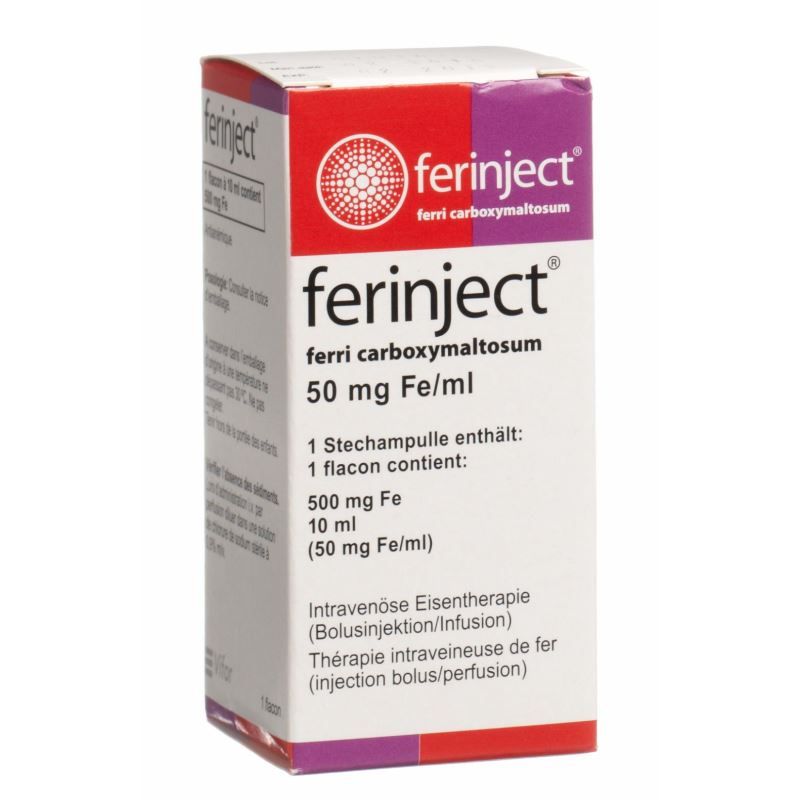
Type:10ml Vial
Generic Name:Ferric Carboxymaltose
Manufacturer:Unimed Unihealth Pharmaceuticals Ltd.
Price:৳3114.80
Iron deficiency anemia
IV Preparation For IV infusion, dilute in up to 250 mL 0.9% NaCl; resulting concentration should be >2 mg/mL IV Administration IV push: May administer undiluted at rate of 100 mg/minute IV infusion: Dilute dose in up to 250 mL 0.9% NaCl and infuse over at least 15 minutes
Injection Iron-deficiency Anemia Indicated for treatment of iron deficiency anemia (IDA) in adults who have intolerance or an unsatisfactory response to oral iron; also indicated for IDA in adults with nondialysis dependent chronic kidney disease >50 kg: 750 mg IV once, follow 7 days later with second 750 mg dose; not to exceed cumulative dose of 1500 mg per course <50 kg: 15 mg/kg IV once, follow 7 days later with second dose; not to exceed 1500 cumulative dose per course
Safety and efficacy not established
Hypersensitivity to any of its components.
Non-dextran, IV is a colloidal iron hydroxide in complex with carboxymaltose, a carbohydrate polymer that releases iron; replaces iron stores found in hemoglobin, myoglobin, and enzymes; works to transport oxygen via hemoglobin Macrophage engulf FCM from blood and control iron release. Transferrin saturates and , Iron into the liver, spleen and Bone marrow.
Hypersensitivity Reactions Serious hypersensitivity reactions, including anaphylactic-type reactions, some of which have been life-threatening and fatal, have been reported in patients receiving Ferric carboxymaltose. Patients may present with shock, clinically significant hypotension, loss of consciousness, and/or collapse. Monitor patients for signs and symptoms of hypersensitivity during and after Ferric carboxymaltose administration for at least 30 minutes and until clinically stable following completion of the infusion. Only administer Ferric carboxymaltose when personnel and therapies are immediately available for the treatment of serious hypersensitivity reactions. Other serious or severe adverse reactions potentially associated with hypersensitivity which included, but not limited to, pruritus, rash, urticaria, wheezing, or hypotension may occur. Hypertension Transient elevations in systolic blood pressure, sometimes occurring with facial flushing, dizziness, or nausea were observed. These elevations generally occurred immediately after dosing and resolved within 30 minutes. Monitor patients for signs and symptoms of hypertension following each Ferric carboxymaltose administration. Lactation Clinical studies showed that transfer of iron from Ferric Carboxymaltose to human milk was negligible (≤1%). Based on limited data on breast-feeding women it is unlikely that Ferric Carboxymaltose represents a risk to the breast-fed child.
1-10% Nausea (7.2%),Hypertension (3.8%),Flushing (3.6%),Decreased blood phosphorus (2.1%),Dizziness (2%),Vomiting (1.7%),Pruritus (1.5%),Rash (1.5%),Urticaria (1.5%),Wheezing (1.5%),Injection site discoloration (1.4%),Headache (1.2%),Increased alanine aminotransferase (1.1%),Dysgeusia (1.1%),Hypotension 1%) <1% Constipation (0.5%),Serious anaphylactic/anaphylactoid reactions (0.1%)
Pregnancy Studies on use in pregnant women have not reported adverse developmental outcomes; however, these studies cannot establish or exclude absence of any drug-related risk during pregnancy because studies were not designed to assess for risk of major birth defects; there are risks to mother and fetus associated with untreated iron deficiency anemia (IDA) in pregnancy Untreated iron deficiency anemia (IDA) in pregnancy is associated with adverse maternal outcomes such as post-partum anemia; adverse pregnancy outcomes associated with IDA include increased risk for preterm delivery and low birth weight Lactation Available published data on use of ferric carboxymaltose in lactating women demonstrate that iron is present in breast milk; however, the data do not inform the full potential exposure of iron for breastfed infant; among breastfed infants, there were no adverse events reported that were considered related to ferric carboxymaltose exposure through breastmilk; there is no information on effects of ferric carboxymaltose on milk production; developmental and health benefits of breastfeeding should be considered along with mother’s clinical need for therapy in addition to any potential adverse effects on breastfed child from drug or from underlying maternal condition